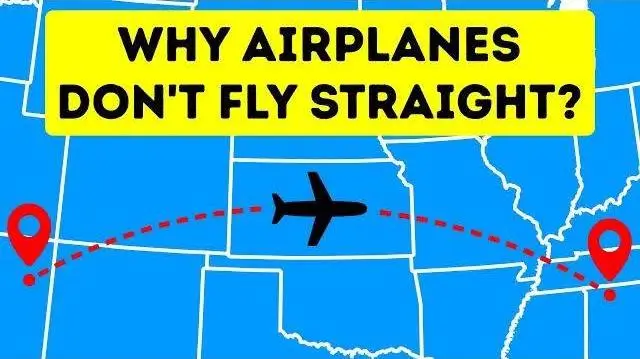Why do Airplanes fly in a curve instead of straight forward?
Airplanes typically fly in curved paths for two main reasons: efficiency and safety.
Efficiency
Aircraft follow curved flight paths to take advantage of the Earth’s rotation and the natural wind patterns in the atmosphere. The Earth rotates from west to east, causing the air to move with it. This phenomenon is known as the Coriolis effect. By flying in a curved path, aircraft can take advantage of the prevailing winds, which can significantly reduce fuel consumption and travel time. These wind patterns are often referred to as jet streams. Pilots and airlines carefully plan routes to utilize these favorable winds, resulting in more efficient flights.
Safety
Another reason for flying in curved paths is safety. Air traffic control systems are designed to manage the flow of aircraft efficiently and prevent collisions. By following predetermined routes and flying in designated airways, pilots can maintain separation from other aircraft, minimizing the risk of mid-air collisions. These airways are carefully planned to ensure safe distances between aircraft, and they often follow curved paths to facilitate this separation.
While airplanes may appear to fly in straight lines when viewed from the ground, their flight paths are typically a series of connected curved segments. This allows them to optimize their routes for efficiency, taking into account the Earth’s rotation and wind patterns, while still ensuring safety by adhering to established air traffic control procedures.
हवाई जहाज़ सीधे आगे की बजाय घुमावदार दिशा में क्यों उड़ते हैं?
हवाई जहाज आमतौर पर दो मुख्य कारणों से घुमावदार रास्तों पर उड़ान भरते हैं: दक्षता और सुरक्षा।
दक्षता
विमान पृथ्वी के घूर्णन और वायुमंडल में प्राकृतिक हवा के पैटर्न का लाभ उठाने के लिए घुमावदार उड़ान पथ का अनुसरण करते हैं। पृथ्वी पश्चिम से पूर्व की ओर घूमती है, जिससे हवा उसके साथ चलती है। इस घटना को कोरिओलिस प्रभाव के रूप में जाना जाता है। घुमावदार रास्ते में उड़ान भरकर, विमान प्रचलित हवाओं का लाभ उठा सकते हैं, जिससे ईंधन की खपत और यात्रा के समय में काफी कमी आ सकती है। इन पवन पैटर्न को अक्सर जेट स्ट्रीम के रूप में जाना जाता है। पायलट और एयरलाइंस इन अनुकूल हवाओं का उपयोग करने के लिए सावधानीपूर्वक मार्गों की योजना बनाते हैं, जिसके परिणामस्वरूप अधिक कुशल उड़ानें होती हैं।
सुरक्षा
घुमावदार रास्तों में उड़ान भरने का दूसरा कारण सुरक्षा है। हवाई यातायात नियंत्रण प्रणाली को विमान के प्रवाह को कुशलतापूर्वक प्रबंधित करने और टकराव को रोकने के लिए डिज़ाइन किया गया है। पूर्व निर्धारित मार्गों का पालन करके और निर्दिष्ट वायुमार्गों में उड़ान भरकर, पायलट अन्य विमानों से अलग रह सकते हैं, जिससे मध्य हवा में टकराव का जोखिम कम हो जाता है। विमानों के बीच सुरक्षित दूरी सुनिश्चित करने के लिए इन वायुमार्गों की सावधानीपूर्वक योजना बनाई गई है, और इस अलगाव को सुविधाजनक बनाने के लिए वे अक्सर घुमावदार रास्तों का पालन करते हैं।
जबकि ज़मीन से देखने पर हवाई जहाज़ सीधी रेखाओं में उड़ते हुए प्रतीत हो सकते हैं, उनके उड़ान पथ आम तौर पर जुड़े हुए घुमावदार खंडों की एक श्रृंखला होते हैं। यह उन्हें पृथ्वी के घूर्णन और हवा के पैटर्न को ध्यान में रखते हुए, दक्षता के लिए अपने मार्गों को अनुकूलित करने की अनुमति देता है, साथ ही स्थापित हवाई यातायात नियंत्रण प्रक्रियाओं का पालन करके सुरक्षा सुनिश्चित करता है।




